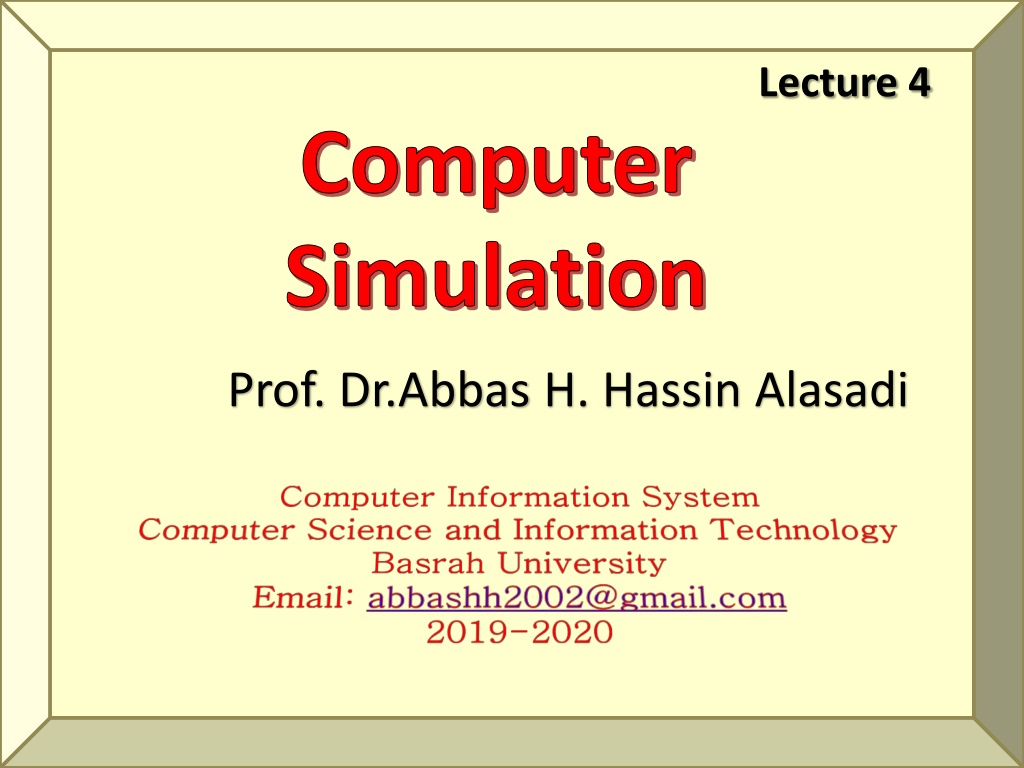
Understanding Simulation Techniques in System Analysis
Explore the nuances of discrete-event, continuous, and Monte Carlo simulations in system analysis. Learn how each type of simulation is applied, the characteristics of systems they model, and their relevance in various fields.
Download Presentation

Please find below an Image/Link to download the presentation.
The content on the website is provided AS IS for your information and personal use only. It may not be sold, licensed, or shared on other websites without obtaining consent from the author. Download presentation by click this link. If you encounter any issues during the download, it is possible that the publisher has removed the file from their server.
E N D
Presentation Transcript
Lecture 4 Computer Simulation Prof. Dr.Abbas H. Hassin Alasadi abbashh2002@gmail.com
Concepts of Discrete-Event Simulation Basically, there are three types of simulation; discrete event, continuous, and MonteCarlo. Discrete event simulation is appropriate for systems whose state is discrete and changes at particular time point and then remains in that state for some time. A simulation methodology in which events cause the state of the system to change at specific points in time. 2
Discrete-Event Simulation An example of such a system is the number of customers in a post office: The number of customers is discrete (integer) and the number of customers only changes when someone enters the post office or finishes its business at the counter. 3
Continuous-Event Simulation The state variables change in a continuous way, and not sudden from one state to another (infinite number of states). Continuous simulation is appropriate for systems with a continuous state that changes continuously over time. An example of such a system is the amount of liquid in a tank and or its temperature. Such a system can be described by differential equations. Continuous simulation is a technique to solve these equations numerically. 4
Monte Carlo Simulation Monte Carlo Simulation is a mathematical technique that generates random variables for modelling risk or uncertainty of a certain system. The random variables or inputs are modelled on the basis of probability distributions such as normal, log normal, etc. Different iterations or simulations are run for generating paths and the outcome is arrived at by using suitable numerical computations. Monte Carlo Methods are now used to solve problems in numerous fields including applied statistics, engineering, finance and business, design and visuals, computing, telecommunications, and the physical sciences. 5
Concepts of Discrete-Event Simulation System : A collection of entities (e.g., people and machines) that interact together over time to accomplish one or more goals. Model : An abstract representation of a system, usually containing structural, logical, or mathematical relationships which describe a system in terms of state, entities and their attributes, sets, processes, events, activities, and delays. System state: A collection of variables that contain all the information necessary to describe the system at any time. 6
Concepts of Discrete-Event Simulation Entity: Any object or component in the system which requires explicit representation in the model (e.g., a server, a customer, a machine). Attributes : The properties of a given entity (e.g., the priority of a waiting customer, the routing of a job through a job shop). List : A collection of (permanently or temporarily) associated entities, ordered in some logical fashion (such as all customers currently in a waiting line, ordered by first come, first served, or by priority). Event: An instantaneous occurrence that changes the state of a system (such as an arrival of a new customer). 7
Concepts of Discrete-Event Simulation Event notice: A record of an event to occur at the current or some future time, along with any associated data necessary to execute the event; at a minimum, the record includes the event type and the event time. Event list: A list of event notices for future events, ordered by time of occurrence; also known as the future event list (FEL). Activity: A duration of time of specified length (e.g., a service time or interarrival time), which is known when it begins (although it may be defined in terms of a statistical distribution). 8
Concepts of Discrete-Event Simulation Delay: A duration of time of unspecified indefinite length, which is not known until it ends (e.g., a customer's delay in a last-in, first-out waiting line which, when it begins, depends on future arrivals). Clock : A variable representing simulated time, called CLOCK in the examples to follow. 9
Concepts of Discrete-Event Simulation The End of Lecture 4 10
